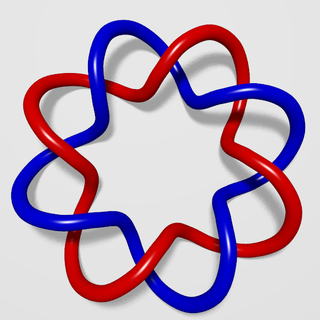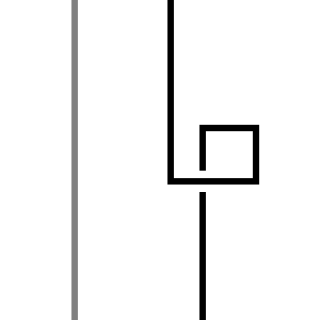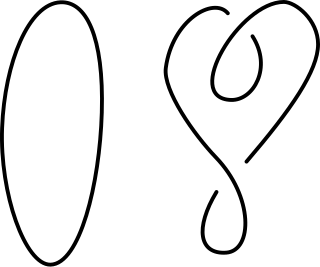Related Research Articles

In mathematics, curvature is any of several strongly related concepts in geometry. Intuitively, the curvature is the amount by which a curve deviates from being a straight line, or a surface deviates from being a plane.

In the mathematical field of topology, knot theory is the study of mathematical knots. While inspired by knots which appear in daily life, such as those in shoelaces and rope, a mathematical knot differs in that the ends are joined so it cannot be undone, the simplest knot being a ring. In mathematical language, a knot is an embedding of a circle in 3-dimensional Euclidean space, . Two mathematical knots are equivalent if one can be transformed into the other via a deformation of upon itself ; these transformations correspond to manipulations of a knotted string that do not involve cutting it or passing through itself.

In mathematics, a knot is an embedding of the circle S1 into three-dimensional Euclidean space, R3. Often two knots are considered equivalent if they are ambient isotopic, that is, if there exists a continuous deformation of R3 which takes one knot to the other.
The Chern–Simons theory is a 3-dimensional topological quantum field theory of Schwarz type developed by Edward Witten. It was discovered first by mathematical physicist Albert Schwarz. It is named after mathematicians Shiing-Shen Chern and James Harris Simons, who introduced the Chern–Simons 3-form. In the Chern–Simons theory, the action is proportional to the integral of the Chern–Simons 3-form.

In mathematics, the linking number is a numerical invariant that describes the linking of two closed curves in three-dimensional space. Intuitively, the linking number represents the number of times that each curve winds around the other. In Euclidean space, the linking number is always an integer, but may be positive or negative depending on the orientation of the two curves.

In mathematics, contact geometry is the study of a geometric structure on smooth manifolds given by a hyperplane distribution in the tangent bundle satisfying a condition called 'complete non-integrability'. Equivalently, such a distribution may be given as the kernel of a differential one-form, and the non-integrability condition translates into a maximal non-degeneracy condition on the form. These conditions are opposite to two equivalent conditions for 'complete integrability' of a hyperplane distribution, i.e. that it be tangent to a codimension one foliation on the manifold, whose equivalence is the content of the Frobenius theorem.

In differential geometry, the Frenet–Serret formulas describe the kinematic properties of a particle moving along a continuous, differentiable curve in three-dimensional Euclidean space R3, or the geometric properties of the curve itself irrespective of any motion. More specifically, the formulas describe the derivatives of the so-called tangent, normal, and binormal unit vectors in terms of each other. The formulas are named after the two French mathematicians who independently discovered them: Jean Frédéric Frenet, in his thesis of 1847, and Joseph Alfred Serret, in 1851. Vector notation and linear algebra currently used to write these formulas were not yet in use at the time of their discovery.
Teleparallelism, was an attempt by Albert Einstein to base a unified theory of electromagnetism and gravity on the mathematical structure of distant parallelism, also referred to as absolute or teleparallelism. In this theory, a spacetime is characterized by a curvature-free linear connection in conjunction with a metric tensor field, both defined in terms of a dynamical tetrad field.

In mathematics, a 3-manifold is a space that locally looks like Euclidean 3-dimensional space. A 3-manifold can be thought of as a possible shape of the universe. Just as a sphere looks like a plane to a small enough observer, all 3-manifolds look like our universe does to a small enough observer. This is made more precise in the definition below.

In the mathematical area of knot theory, a Reidemeister move is any of three local moves on a link diagram. Kurt Reidemeister (1927) and, independently, James Waddell Alexander and Garland Baird Briggs (1926), demonstrated that two knot diagrams belonging to the same knot, up to planar isotopy, can be related by a sequence of the three Reidemeister moves.

In mathematics, a Seifert surface is an orientable surface whose boundary is a given knot or link.
In mathematics, Khovanov homology is an oriented link invariant that arises as the homology of a chain complex. It may be regarded as a categorification of the Jones polynomial.
In mathematics, Floer homology is a tool for studying symplectic geometry and low-dimensional topology. Floer homology is a novel invariant that arises as an infinite-dimensional analogue of finite-dimensional Morse homology. Andreas Floer introduced the first version of Floer homology, now called Lagrangian Floer homology, in his proof of the Arnold conjecture in symplectic geometry. Floer also developed a closely related theory for Lagrangian submanifolds of a symplectic manifold. A third construction, also due to Floer, associates homology groups to closed three-dimensional manifolds using the Yang–Mills functional. These constructions and their descendants play a fundamental role in current investigations into the topology of symplectic and contact manifolds as well as (smooth) three- and four-dimensional manifolds.

In mathematics, the unknotting problem is the problem of algorithmically recognizing the unknot, given some representation of a knot, e.g., a knot diagram. There are several types of unknotting algorithms. A major unresolved challenge is to determine if the problem admits a polynomial time algorithm; that is, whether the problem lies in the complexity class P.

In mathematics, the Arf invariant of a nonsingular quadratic form over a field of characteristic 2 was defined by Turkish mathematician Cahit Arf (1941) when he started the systematic study of quadratic forms over arbitrary fields of characteristic 2. The Arf invariant is the substitute, in characteristic 2, for the discriminant for quadratic forms in characteristic not 2. Arf used his invariant, among others, in his endeavor to classify quadratic forms in characteristic 2.

In mathematical study of the differential geometry of curves, the total curvature of an immersed plane curve is the integral of curvature along a curve taken with respect to arc length:
In the mathematical field of knot theory, a quantum knot invariant or quantum invariant of a knot or link is a linear sum of colored Jones polynomial of surgery presentations of the knot complement.
In mathematics, the Hitchin integrable system is an integrable system depending on the choice of a complex reductive group and a compact Riemann surface, introduced by Nigel Hitchin in 1987. It lies on the crossroads of algebraic geometry, the theory of Lie algebras and integrable system theory. It also plays an important role in geometric Langlands correspondence over the field of complex numbers; related to conformal field theory. A genus zero analogue of the Hitchin system arises as a certain limit of the Knizhnik–Zamolodchikov equations. Almost all integrable systems of classical mechanics can be obtained as particular cases of the Hitchin system.

In geometry, a quadrisecant or quadrisecant line of a space curve is a line that passes through four points of the curve. This is the largest possible number of intersections that a generic space curve can have with a line, and for such curves the quadrisecants form a discrete set of lines. Quadrisecants have been studied for curves of several types:

In mathematics, the curve-shortening flow is a process that modifies a smooth curve in the Euclidean plane by moving its points perpendicularly to the curve at a speed proportional to the curvature. The curve-shortening flow is an example of a geometric flow, and is the one-dimensional case of the mean curvature flow. Other names for the same process include the Euclidean shortening flow, geometric heat flow, and arc length evolution.
References
- ↑ Sumners, De Witt L.; Cruz-White, Irma I.; Ricca, Renzo L. (2021). "Zero helicity of Seifert framed defects". J. Phys. A . 54 (29): 295203. Bibcode:2021JPhA...54C5203S. doi:10.1088/1751-8121/abf45c. S2CID 233533506.
- Chernov, Vladimir (2005), "Framed knots in 3-manifolds and affine self-linking numbers", Journal of Knot Theory and its Ramifications, 14 (6): 791–818, arXiv: math/0105139 , doi:10.1142/S0218216505004056, MR 2172898 .
- Moskovich, Daniel (2004), "Framing and the self-linking integral", Far East Journal of Mathematical Sciences, 14 (2): 165–183, arXiv: math/0211223 , Bibcode:2002math.....11223M, MR 2105976